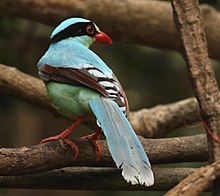Common green magpie
This article needs additional citations for verification. (July 2017) |
| Common green magpie | |
|---|---|

| |
| In Kaeng Krachan National Park, Thailand | |
| Scientific classification | |
| Domain: | Eukaryota |
| Kingdom: | Animalia |
| Phylum: | Chordata |
| Class: | Aves |
| Order: | Passeriformes |
| Family: | Corvidae |
| Genus: | Cissa |
| Species: | C. chinensis
|
| Binomial name | |
| Cissa chinensis (Boddaert, 1783)
| |


The common green magpie (Cissa chinensis) is a member of the crow family, roughly about the size of the Eurasian jay or slightly smaller. It is a vivid green in colour (often fades to turquoise in captivity), slightly lighter on the underside and has a thick black stripe from the bill (through the eyes) to the nape. Compared to the other members of its genus, the white-tipped tail is quite long. This all contrasts vividly with the red fleshy eye rims, bill and legs. The wings are reddish maroon. When dead, the colour of the bird changes into blue (according to H.J. Noltie's Natural History Drawings from the Collection of Sir Thomas Stamford Raffles).
It is found from the lower Himalayas in north eastern India in a broad south easterly band down into central Thailand, Malaysia, Sumatra and northwestern Borneo in evergreen forest (including bamboo forest), clearings and scrub.
This bird seeks food both on the ground and in trees, and takes a very high percentage of animal prey from countless invertebrates, small reptiles, mammals and young birds and eggs. It will also take flesh from a recently killed carcass.
The nest is built in trees, large shrubs and often in tangles of various climbing vines. There are usually 4–6 eggs laid.
The voice is quite varied but often a harsh peep-peep. It also frequently whistles and chatters.

